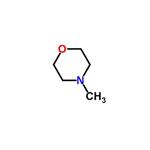Chemical Properties
colorless and transparent liquid. with characteristic odor. soluble in organic solvents, miscible with water and ethanol.
Uses
4-Methylmorpholine is an excellent solvent, emulsifier, corrosion inhibitor, Catalyst in polyurethane foamsextraction solvent, stabilizing agent for chlorinated hydrocarbons, and also can be used as pesticide intermediates. 4-Methylmorpholine is widely used in the synthesis of pesticide compounds such as insecticide, fungicide, plant growth regulator, etc. It is also used in the synthesis of fine chemicals such as surfactant, lubricant coolant, metal antirust agent, fiber treatment agent, etc.
Preparation
4-Methylmorpholine preparation method is to slowly add formaldehyde in morpholine drop by drop, under stirring add formic acid reaction, automatic reflux, and release carbon dioxide. After adding formic acid, heating reflux 4 ~ 5h, cooling and adding sodium hydroxide immediately distillation, collect all the fraction before the boiling point of 99 ℃, and then add sodium hydroxide in the fraction to saturation, cooling the oil layer, drying, fractional distillation, to obtain N-methylmorpholine.
General Description
4-Methylmorpholine is a water-white liquid with an ammonia-like odor. Less dense than water and insoluble in water. Flash point 75°F. May be moderately toxic by ingestion, inhalation and skin absorption. Very irritating to skin, eyes, and mucous membranes. Used as a solvent and to make pharmaceuticals.
Air & Water Reactions
Highly flammable. Insoluble in water.
Reactivity Profile
Amines are chemical bases. They neutralize acids to form salts plus water. These acid-base reactions are exothermic. The amount of heat that is evolved per mole of amine in a neutralization is largely independent of the strength of the amine as a base. Amines may be incompatible with isocyanates, halogenated organics, peroxides, phenols (acidic), epoxides, anhydrides, and acid halides. Flammable gaseous hydrogen is generated by amines in combination with strong reducing agents, such as hydrides.
Health Hazard
May cause toxic effects if inhaled or ingested/swallowed. Contact with substance may cause severe burns to skin and eyes. Fire will produce irritating, corrosive and/or toxic gases. Vapors may cause dizziness or suffocation. Runoff from fire control or dilution water may cause pollution.
Fire Hazard
Flammable/combustible material. May be ignited by heat, sparks or flames. Vapors may form explosive mixtures with air. Vapors may travel to source of ignition and flash back. Most vapors are heavier than air. They will spread along ground and collect in low or confined areas (sewers, basements, tanks). Vapor explosion hazard indoors, outdoors or in sewers. Runoff to sewer may create fire or explosion hazard. Containers may explode when heated. Many liquids are lighter than water.
Flammability and Explosibility
Flammable
Purification Methods
Dry it by refluxing with BaO or sodium, then fractionally distil it through a helices-packed column. The picrate has m 227o, the thiocyanate salt has m 103o (from butanone). [Hall J Phys Chem 60 63 1956, Beilstein 27 I 203, 27 III/IV 22.]







